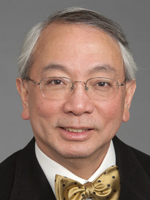Steven H. Wong, PhD

Dr. Wong
June 2017—Mass spectrometry has been gaining acceptance for routine assays in clinical laboratories. The 6th Annual AACC Conference on Mass Spectrometry and Separation Sciences for Laboratory Medicine, held in fall 2016, spotlighted best practices in the use of mass spectrometry testing for patient-centered care. It also was a forum for how advanced mass-spectrometry-based technologies such as tissue imaging and novel clinical applications are emerging as a crucial component of clinical decision-making in precision medicine programs. This trend points to the emerging adaptations beyond clinical pathology/clinical chemistry to other areas of pathology and medicine. As such, these advances might be regarded as the next generation of clinical mass spectrometry (MS), providing complementary next-generation molecular analysis for precision medicine. Here are highlights of six of the 19 conference presentations.
Amanda G. Paulovich, MD, PhD, of the Fred Hutchinson Cancer Research Center, gave the authoritative opening plenary lecture, which focused on translational MS for proteomics and peptides. The use of diagnostic biomarkers is essential for the realization of precision medicine and in translational research. Yet there are biomarker diagnostic assays currently for fewer than 600 proteins (laboratory developed and FDA cleared), a fraction (one to two percent) of the total number of proteins encoded by the human genome, Dr. Paulovich said. MS-based proteomic assays (multiple reaction monitoring, also referred to as selected reaction monitoring) have emerged as a viable platform for protein assays in modern disease management. Dr. Paulovich presented case studies of this method applied to different types of biospecimens for applications ranging from biomarker measurements to pharmacodynamic studies. Dr. Paulovich, a professor in the Division of Oncology, University of Washington School of Medicine, also talked about the ongoing efforts of the Clinical Proteomic Tumor Analysis Consortium of the National Cancer Institute to set standards for multiple-reaction-monitoring-based assay qualification and to make highly characterized assays (assays.cancer.gov) and monoclonal antibodies (antibodies.cancer.gov) available to the community.
John D. Pfeifer, MD, PhD, professor of pathology and vice chair for clinical affairs, Department of Pathology, Washington University School of Medicine, offered a keynote address on clinical tissue imaging by MS—“the future is now.” This was based on collaboration with Richard Caprioli, PhD, and Jeremy Norris, PhD, of the National Research Resource for Imaging Mass Spectrometry at Vanderbilt University School of Medicine. Dr. Pfeifer reviewed the resolution that can be achieved for small molecules via matrix-assisted laser desorption ionization imaging mass spectrometry (MALDI IMS) and MS/MS sequence analysis. He explained the diagnostic applications of IMS on routinely processed formalin-fixed, paraffin-embedded tissue sections to differentiate lesions with overlapping morphological features, as demonstrated by the work of dermatopathologist Rossitza Lazova, MD, on the clinical use of IMS for differentiating Spitz nevi from Spitzoid malignant melanomas. He also talked about the clinical uses of IMS likely to emerge in the next few years—for example, quantitation of predictive biomarkers as an alternative to immunohistochemistry and the evaluation of pathway activation via phosphopeptide enrichment on TiO2 surfaces. Finally, Dr. Pfeifer noted that, in recognition of the nascent clinical use of IMS, the CAP is developing checklist requirements for laboratories that perform IMS applications. The requirements will cover the IMS hardware and the associated software tools.
Valentina Pirro, PhD, of Purdue University, delivered another keynote presentation, on the use of ambient ionization MS for brain cancer diagnosis. Dr. Pirro, a research scientist in the chemistry department, detailed the role that ambient ionization MS can play as a diagnostic tool to obtain maximal surgical resection of brain tumors, which is associated with better patient prognosis. Currently, there is no assignment of surgical margins intraoperatively. MRI is used to guide tumor resection but an increasing body of evidence is showing that tumor infiltration can extend beyond the MRI contrast-enhancing regions. The MS molecular signature of neurological tissue provides information on tumor pathology and can distinguish cancerous tissue from normal brain parenchyma and estimate the degree of tumor infiltration. Ambient ionization provides a means for ion generation from unprocessed neurological tissue and is the suitable approach for rapid molecular diagnostics performed directly inside the surgical suite. This approach can be used to map tumor heterogeneity and examine the resection cavity for residual tumor.
Dr. Pirro highlighted how ambient ionization MS can be integrated online or offline into the surgical workflow. Online techniques, such as the I-knife, require the use of a special surgical handpiece but allow for real-time in vivo analysis of tissue. Offline strategies like DESI analyze tissue biopsies ex vivo within minutes but are applicable to any surgical method with no alteration in procedures.
 CAP TODAY Pathology/Laboratory Medicine/Laboratory Management
CAP TODAY Pathology/Laboratory Medicine/Laboratory Management
